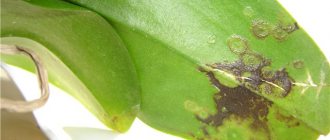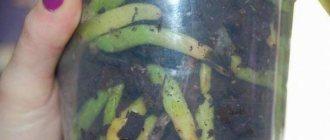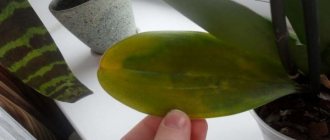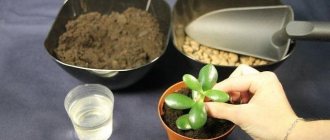4
(4)
Contrary to the common myth that orchids are difficult to grow, many gardeners have been successfully collecting these wonderful plants for a long time. If you follow simple rules of care, they will grow well and bloom profusely. But when errors arise in the maintenance of orchids, they immediately let you know about it. One common mistake is overwatering. Fungal diseases develop from excess moisture. This includes mold; it can appear on the roots and in the axils of the leaves. In our article we will talk about why diseases develop and how to deal with them.
Appearance
Mold is a coating formed by mold fungi on the surface of plants. The so-called “seeds” of mushrooms (spores in scientific terms) move freely around the room and can easily infect not only flowers, but also various surfaces.
Color varies from light gray to greenish. Mold looks like a furry crust on the surface of the flower .
Reference! Often, mold can appear on the roots of an orchid, but the roots, stem and leaves of the flower itself are susceptible to this disease.
Pathogens of phyllosticosis
The disease is caused by one of the fungi of the genus Phyllosticta. More often than others, two types of spores appear on orchids:
- Mycosphaerella zeae-maydis (synonym of Phyllosticta maydis);
- Phyllosticta capitalensis (synonym of Phyllostictina pyriformis).
Their manifestations are extremely diverse. As a rule, brown spots of various shapes and sizes are observed on the foliage of fruit trees - cherries, apple trees, sweet cherries, and plums. On the leaf blades of orchids, the signs of the presence of the disease are completely different - at the initial stage there are small black dots, which over time transform into stripes, streaks, diamonds, and large spots of indeterminate shape.
Due to the color of the affected areas, in the countries of the Asian continent the disease is known as black spot of tuberidia and leaves. A fungal infection caused by Mycosphaerella zeae-maydis is often called black ring spot because its first manifestations are dark, almost black, rings that merge over time into large, uniform areas.
How to get rid of it?
Let us consider in more detail what to do in this situation, how to combat the formation of this disease on various parts of the flower.
On the leaves
There are two types - white and black.
If white mold appears on the surface and in the axils of the leaves, this is the initial stage of the disease. You can fight it with a solution of copper sulfate. To do this, take a teaspoon of vitriol and dilute it in 2 liters of water. The solution should be a pale blue color . They should wipe the leaves, especially carefully in places where mold accumulates the most. Or spray 2 times a day until the plaque disappears.
If black mold has already appeared on the flower, then it is better to carefully trim the affected leaves and wipe the cut areas with the same vitriol solution.
On the roots
This type of fungus is more difficult to fight.
- First of all, it is necessary to completely dry the substrate in which the orchid grows.
- Then it is recommended to thoroughly loosen the soil, remove the flower itself from the pot and thoroughly rinse the damaged areas (recommended water temperature 35 degrees); if dried roots are found, it is better to carefully trim them.
- Place the treated flower (stems and roots) in the fungicide solution for 15 minutes.
Important! The fungicide solution should be concentrated to 1/6 of the concentration stated in the instructions. Otherwise, you may get a chemical burn to the flower.
In the substrate
Moldy soil is best disposed of . Before planting the orchid in a new substrate, you need to soak it (soil) in boiling water for about 15 minutes. After this, wait until it dries completely and only then fill the container where you place the orchid.
It is recommended to put 3 crushed tablets of activated carbon or wood bark into the substrate. After planting, it is not recommended to water the orchid for about 3-5 days. This is done to ensure that the damaged areas heal and new problem areas do not form. It is also advisable to place the orchid in a well-lit, dry place.
Below you can watch a video that tells you what to do with mold on an orchid:
If the entire plant is affected
If the flower is completely covered with mold, then you can try to carefully cut off the mold with a sharp knife , then treat the damaged areas with a solution of copper sulfate (how to prepare it is indicated above).
It is also recommended to transplant the flower into another pot with a new substrate, previously disinfected. After this, do not water the flower for 5 days and keep it in conditions with minimal air humidity, preferably in direct sunlight. Even in this case, you can use ultraviolet lamps and warm the orchid with them.
Advice! The main thing is not to overdo it, so as not to get a thermal burn of the flower. If these measures do not help, then the flower must be disposed of; nothing can help it, no matter how sad it may sound.
What can cause white blossoms?
The main factor for the active spread of fungus on an orchid is too high air humidity and too intensive spraying. For some types of orchids, such as phalaenopsis, foliar irrigation is completely contraindicated. For many other species, spraying is indicated only for the root system.- The second factor is very intensive watering . If there are not only signs of a flower being damaged by a fungus, but also rotting of the roots or the stems themselves, then it is necessary to limit the amount of watering (we talked more about whether it is possible to save an orchid from rot and what are the reasons for its appearance here).
It is necessary to water the orchid only when the entire substrate is dry. Watering is done by immersing the pot in water for about 30 minutes.
- The third factor is too cold or too hard water . It is advisable to water the orchid with bottled or rain water, allowing it to settle first. The water should be at room temperature.
- The fourth factor is stagnation of moisture in the core or axils of the leaves . To avoid this, after spraying and watering, be sure to remove water from the axils of the leaves or from the core of the rosette.
- The fifth factor is where the flower lives is too high If the heat is combined with high humidity, the fungus on the orchid will not take long to appear.
- The sixth factor is dead leaves and flowers not removed in time . From them, the fungus can first infect the soil, and then the entire plant.
How not to treat a flower?
- Under no circumstances should high humidity be allowed in the room where the flower is located.
- Don't overdo the chemicals used to combat mold.
- Although drying and a sunny place for treating the flower are recommended, one should not forget that prolonged exposure to direct sunlight (especially in the hot summer period) can lead to thermal burn of a delicate orchid.
- If you use a solution of copper sulfate or fungicide, then you should not allow a high concentration of these chemicals, as this can cause a chemical burn to the flower.
Prevention
To do this, you need to make drainage holes in the pot where the flower grows. The substrate in which the orchid is located must be dried occasionally, that is, do not water it for several days. It is best to use clean filtered water for irrigation.
Occasionally add a weak solution of potassium permanganate to the water for irrigation (the color should be soft pink, not brighter). Sometimes you can add a couple of tablets of activated carbon or tree bark to the orchid substrate. Maintain temperature conditions. The optimal temperature is 22-25 degrees. Avoid high humidity and it is best to place the flower in a sunny place.
Why does a plant get moldy?
The most optimal conditions for mold to grow are warmth and humidity.
Most often, trouble occurs due to improper care. In this case, the plant weakens and its immunity decreases.
Very often, gardeners themselves provoke the appearance of mold on orchids:
- abundant watering and frequent heavy spraying if the flower is in a hot room;
- flower pots stand very closely, preventing the free movement of air between plants;
- the pathogens were brought from the store along with the substrate.
Post-treatment care
An orchid that has suffered a fungal disease is best placed for a while away from other plants. It is advisable that it be a dry, warm, well-ventilated room. Provide the flower with access to the sun. Also, after treatment and removal of mold, it is best not to water the flower for several days; it is necessary to periodically loosen the soil in which the orchid grows.
The renewed substrate can be treated with a solution of foundationazole (two grams per liter of water). Twice a month it is recommended to dilute 0.5 teaspoon of citric acid in a glass of water and water the plant with this solution. Some gardeners recommend dropping a few cloves of garlic into the orchid pot after watering. You need to keep them there until the soil dries completely after watering and then remove them.
You can also use dried citrus peels . Place them around the flower for a couple of days.
Orchids are also susceptible to other diseases. Read about yellowing, wilting, drying, rotting, plaque, cracking of leaves, falling of flowers and leaves, baying.
So, we have figured out why the roots and other parts of the orchid become moldy and what to do about it. The most important thing is not to panic when you notice signs of this disease, but to provide timely assistance to the flower. Regularly inspect the flower for symptoms of mold and follow simple rules for caring for the plant. Periodically carry out preventative maintenance on your orchid and then it will delight you with its color for a long time.
Defeat
Leaves
The leaf blade is most often affected by white mold. If white mold is found on orchids - what to do?
- First, you need to arrange watering . Since such a disease has already appeared, then excess moisture is clearly present.
- In addition, you should pay attention to spraying , perhaps it is too frequent.
- It is possible that the air in the room is simply too humid, which harms not only plants, but also human health. In this case, it is necessary to regularly ventilate the room or even resort to using a special dehumidifier.
In order to remove some of the spores and the fungi themselves, it is recommended to treat the leaves with a solution of copper sulfate.
Copper sulfate solution: dissolve 1 teaspoon of copper sulfate in two liters of settled water. Wipe the leaves with a cotton swab or spray, but not often, otherwise it will still be damp.
Particular attention should be paid to the axils of the leaves and avoid stagnation of water in them.
Roots
It is much more serious if the mold spreads to the root system. If this happens, then you need to immediately carefully remove the plant from the pot to assess the scale of the problem. The roots are washed under running water, the temperature of which is +35 degrees, and soaked in a fungicide solution , in a ratio of 1 to 6, for 15 minutes.
If rot or soft areas are found on the roots, it is necessary to remove these fragments using a sharp, disinfected blade, and treat the cut areas with crushed activated carbon or cinnamon.
Rotten roots must be cut off.
In order to prevent mold from appearing again, it is better to change the substrate , as there may be spores in it, and also wash the pot. Old bark should be boiled for a few minutes so that it can be safely used in the future.
Peduncles and buds
If the plant is already affected by white mold and has flowered, and the old buds and flower stalks have not been removed, then the fungal disease can begin to spread from them. In this case , you just need to promptly remove dead parts of the plant so as not to provoke the appearance of mold.
Whole plant
You can see mold on a healthy peduncle only if the entire plant has already been captured. Since it has already spread throughout the entire orchid, there is a very high risk that some part is rotting. First you need to pull out the orchid to inspect it, remove excess, then rinse with fungicide. The substrate must be replaced with a new one.
In case of severe rot it is better to remove the flower stalks , since the orchid is now in a painful and weakened state, and flowering requires a lot of effort. After the plant is returned to the washed pot, you should again think about the correct maintenance and understand the reasons for such a rapid spread of the fungus.











